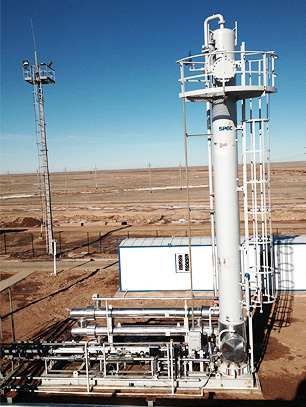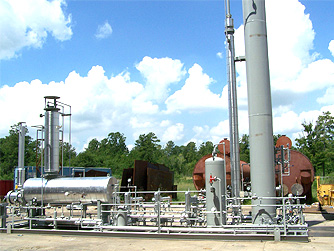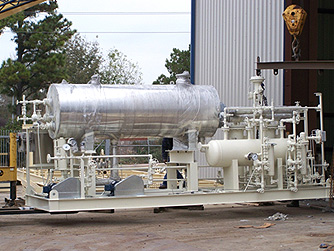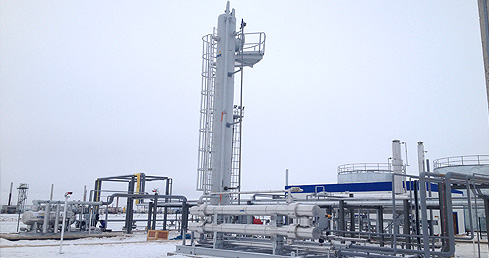Glycol Dehydration
Dehydration of Natural Gas
| When natural gas is extracted from a reservoir, it will typically contain water vapor. The water vapor concentration in the gas depend on the temperature, pressure and conditions of the reservoir bed from which the gas is being extracted. The process of removing water from natural gas is known as dehydration. |
The key factors for dehydrating natural gas are:
Commonly used techniques for gas dehydration include the use of liquid and dry desiccants to achieve the required water concentrations of the gas stream. Except for cryogenic applications, The Glycol Dehydration process is the application of choice. Two types of glycol dehydration are commonly used in the Oil and Gas Industry: Ethylene Glycol (EG) and Triethylene Glycol (TEG). The basic operation of both systems are similar however the choosing which application better suites your process is subject to variable such as operating temperature. |
 |
TEG Process Description
Water saturated natural gas passes through an inlet scrubber to remove contaminants before coming in contact with glycol which helps ensure optimal performance and longevity of the glycol. The scrubbed wet gas enters the contactor tower where it comes in contact with the down-flowing glycol. Trays or structured packing inside the contactor provide adequate contact area for the gylcol to absorb water from the natural gas. As a result, the upward flowing natural gas becomes dryer or leaner, while the lean, downward flowing gylcol becomes water saturated or rich. The lean gas exits the contactor at the top while the rich glycol exits at the bottom
of the contactor.
Advantage of Glycol Dehydration
- Lower initial capital investment required
- Glycol Regeneration is easy and straight forward
- Glycol Dehydration is a continuous process
Limitations of Glycol Dehydration
- Cannot achieve dew point low enough for cryogenic applications
- Glycol can be easily contaminated and will become corrosive
 |
 |
Standard Equipment List
- Absorber
- Inlet Scrubber (typically integrated with Absorber)
- Flash Tank
- Filters
- Glycol Reboiler with Burner Management System
- Surge Tank
- Still Column
- Glycol Pump
- Heat Exchangers
- Analog Pressure/Temperature indicators
- Pneumatic Controllers
- Pneumatic Control Valves
Optional Equipment List
- Process Drain Tank
- Spare Glycol Pumps
- Sparging Tube for Glycol Reboiler\
- Integrated Electro/Pneumatic system with PLC system
Design of Glycol Dehydration System
Glycol systems are used to reduce the inlet and outlet gas flow water dew point specification. The amount of saturated water within the gas is affected by the inlet gas temperature and pressure. If the gas temperature is increased while in contact with free water, more water vapor will be absorbed by the gas. The lower inlet gas pressure, the more water can be absorbed by the gas and the higher water vapor the gas is able to absorbed by the gas and the higher the pressure, the less water vapor the gas is able to absorb. Table 1 below serves as guide to determine the amount of water saturated in the gas at different pressure and temperature.


